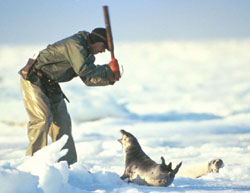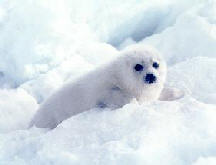|
The department is adopting an Objective Based Fisheries Management approach that uses reference points and control rules to establish management measures for the seal hunt. Reference points are set at 70 percent, 50 percent and 30 percent, based on the maximum observed size of the herd at 5.5 million. The department says it will ensure conservation by maintaining the population at a level above the 70 percent reference point, or 3.85 million.
Under the objective based model, if the full quota is taken over the three year plan, the department estimates the population in 2006 will be about 4.7 million harp seals - well above the 70 percent threshold.
The department will continue to emphasize at-sea surveillance and conduct dockside checks, monitor quotas, check sealers for proper license and observation permits, as well as ensure humane hunting practices, compliance with Marine Mammal Regulations and the proper use of hunting instruments. The department promotes the fullest possible use of each animal harvested.
IFAW says the motivation for the increased quotas is incorrectly based on the idea that seals are eating the dwindling populations of cod. Ten years ago, the federal government declared a moratorium on the cod fishery but the fish stocks have yet to recover.
"The killing of these seals is the government's attempts to hide its own mismanagement of the cod fishery by blaming seals for damage done by human overfishing," said IFAW campaign manager David Loan.
IFAW objects to the seal hunt partly because its observers have found that up to 42 percent of seals are skinned alive. "Several polls have consistently shown the Canadian public is fiercely opposed to the seal hunt, and many Europeans and Americans will avoid buying Canadian products because of the hunt," IFAW says.
"Citizens of Holland will be outraged," said IFAW Holland Director, Marcel Bertsch. "Canada can expect a strong and immediate reaction. We will not stand by and watch this abhorrent practice continue."
|


